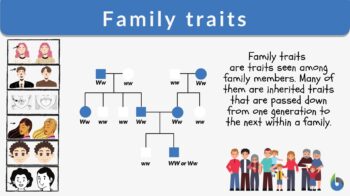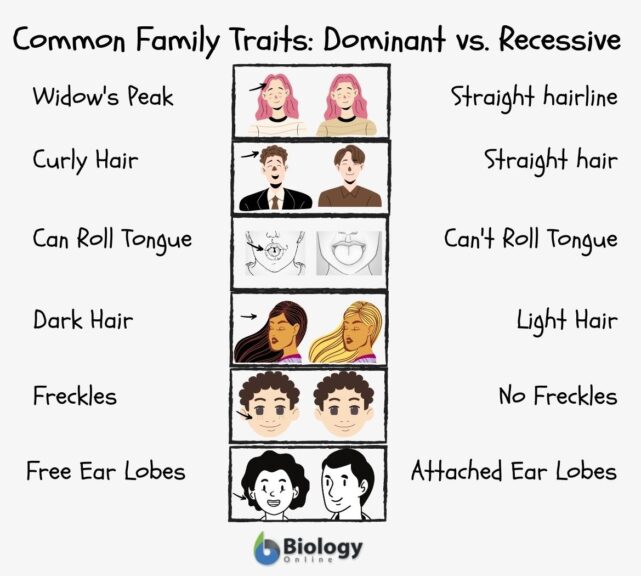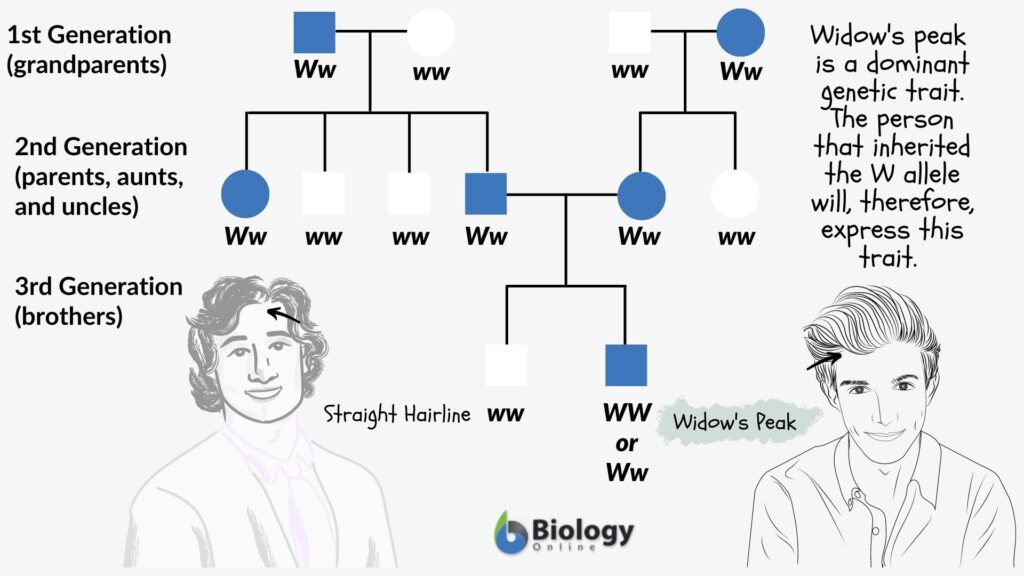
Family trait
n., plural: family traits
[ˈfæmɪli tɹeɪ]
Definition: trait that is palpable among family members, and often genetically determined
Table of Contents
When one thinks of family, they often think of persons who are blood-related to each other as parents to their children and brothers to their sisters. Often, one can tell when people are related because of how they look, they share similar traits. These are often called family traits. What does family trait mean? Let us find out below.
Family Trait Definition
What is a family trait? Family traits refer to the way that family members are alike or similar due to the genes they inherited from their parents. So, how about inherited traits, what are they? Inherited traits are genetically determined traits that are “passed down” from parents to the offspring they create. They are not only based on genetics but the environment plays a massive part in how the traits are shaped. These inherited traits can range from physical to genetic traits – meaning those that may not be able to be seen but are still expressed by and affect the individual. Inherited trait examples can include things like hair color and texture, eye color, skin tone (all physical) as well as blood type, and various diseases (chiefly, genetic). Figure 1 below shows a few family traits that are present in humans.

In biology and genetics, family traits are the traits in which the family members share — meaning, these traits are alike and expressed among the family members. This likeness is largely due to the genes that they inherited from their parents. Inherited traits are genetically determined. They are “passed down” from parents to the offspring.
How are traits inherited? There may be inherited characteristics as well as inherited behaviors in a person. So how do they get these acquired traits? Well, almost all our cells are diploid, meaning every body cell contains two sets of twenty-three (23) chromosomes. The exception to this is our gametes or sex cells, which only have one set of 23 chromosomes. This is because in order for fertilization to occur the egg cell (ovum) of a woman and the sperm cell of a man must fuse together to create one cell (zygote) – the first of the new human.
This new combined cell will now have two sets of 23 chromosomes and is able to grow and form a person. The offspring will now contain in every cell, chromosomes (genes) from both their mother and their father. The passing of traits from parent to offspring is called heredity. Hereditary traits and heritability traits can be a measure of how the differences seen in a person’s genes can account for those differences also seen in their traits. They usually have little to no influence from environmental factors.
Family Tendency – Not a Genetic Trait
Within family traits, we also see family tendencies. How would one define family tendency? Family tendencies occur when there are common family traits that continue throughout members of the same family but have no genetic link to the family. A family tendency is not a genetic trait. This means that a specific trait basically becomes part of a family once it continues to be passed on to the offspring of that family but it’s not genetically connected.
Family tendency examples can include a family of doctors – where a mother, father, their two sons, their niece, and granddaughter are all doctors. Another instance can be family depression, where a son and his grandparents suffer from depression despite his parents not experiencing this illness. Both of these are not genetically linked and so are deemed family tendencies. In Figure 2, we see a family of generations of doctors, which is a family tendency.

Family Trait Examples
The following family trait list will give examples of different family traits and how they are inherited.
1. Alzheimer’s – Alzheimer’s is a form of dementia, a disease that affects the brain by hindering its ability to think, remember, and even the way a person behaves. It is the most common form of dementia and can be developed through a combination of genetics, environmental, and lifestyle behaviors. One of the types of Alzheimer’s is dominantly inherited Alzheimer’s. This means that the inheritance of one Alzheimer’s gene from a parent will cause disease even if the other parent does not pass down that gene. The Alzheimer’s gene will dominate the normal gene. This then becomes a family trait as once a person has the Alzheimer’s gene; their offspring will always inherit the gene and pass it on to the next generation and the cycle continues.
2. Hair color – hair color is something that is almost immediately noticed on a person as we have a lot of hair on our head and body. Hair color is a family trait as usually, you see persons in the family with similar or the same hair color. For instance, when two blond persons create offspring, their offspring usually have blond hair as well. The same goes for red hair. Hair color is caused by the amount of melanin pigment you have in your hair. The type and amount of melanin in a person’s hair are inherited through the genes passed down by their parents. Table 1 below shows the type and amount of melanin that a person needs to obtain black, brown, blond, or red hair. Blond and red hair are rare colors as more than 90% of the world is estimated to have either black or brown hair.
Table 1: Type and amount of melanin that a person needs for particular hair color | |
|---|---|
| Hair Color | Type and amount of melanin |
| Black | Eumelanin: large amount |
| Brown | Eumelanin: moderate amount |
| Blond | Eumelanin: very little amount |
| Red | Eumelanin: little amount; Pheomelanin: large amount |
3. Freckles – often known as the abundance of little “dots” in specific areas of a person’s body. Freckles are flat skin spots and their presence on the skin is another family trait determined by melanin, or rather, the lack thereof (of a specific kind). The gene that the body produces for melanin is the MCIR gene. The body produces both pheomelanin and eumelanin, but usually more of one kind than the other. While the latter will protect the skin from UV rays, pheomelanin will not. Persons who produce more eumelanin will more than likely have darker eyes, hair, and skin and so also are less likely to have freckles which are also affected by sun exposure. However, those persons who produce more pheomelanin are more likely to have lighter hair and eye colors, be fairer in complexion and be more likely to be born with or develop freckles.
4. Hairline shape – Interesting enough, what most persons don’t know is that your hairline shape is also a family trait. The hairline shape is coded for by a gene. This gene is of two variants (alleles), which will determine the hairline shape. One determines a straight hairline and the other for a widow’s peak. The widow’s peak is the dominant trait over the straight hairline and often brings the person’s hairline to a “peak” on their forehead. This means that once the widow’s peak allele is possessed by one parent, the offspring will inherit a widow’s peak hairline. This peak is usually seen among most members of a particular family once the gene is present. Even though the widow’s peak is dominant over the normal hairline, it still isn’t the most common type of hairline. Figure 3 below shows a clear picture of a widow’s peak versus the recessive normal straight hairline.

Try to answer the quiz below to check what you have learned so far about family traits.
References
- Biesecker, L. (2021). Inherited. National Human Genome Research Institution. https://www.genome.gov/genetics-glossary/Inherited
- Medline Plus. (2021). What is heritability? U.S National Library of Medicine. https://medlineplus.gov/genetics/understanding/inheritance/heritability/
- Medline Plus. (2021). Autosomal dominant? U.S National Library of Medicine. https://medlineplus.gov/ency/article/002049.htm
- Medline Plus. (2021). Is hair colour determined by genetics? U.S National Library of Medicine. https://medlineplus.gov/genetics/understanding/traits/haircolor/
- Meleene, M. (2021). What is a family tendency? Love to Know. https://family.lovetoknow.com/about-family-values/what-is-family-tendency-list-common-examples
- Stark, L., Malone, M. & Star, H. (2006). Inherited Human Trait: A quick reference. University of Utah. https://health.utah.gov/genomics/familyhistory/documents/Family%20Reunion/reference%20guide.pdf
- Your Genome. (2021). What is inheritance? Your Genome. https://www.yourgenome.org/facts/what-is-inheritance
©BiologyOnline.com. Content provided and moderated by Biology Online Editors.


